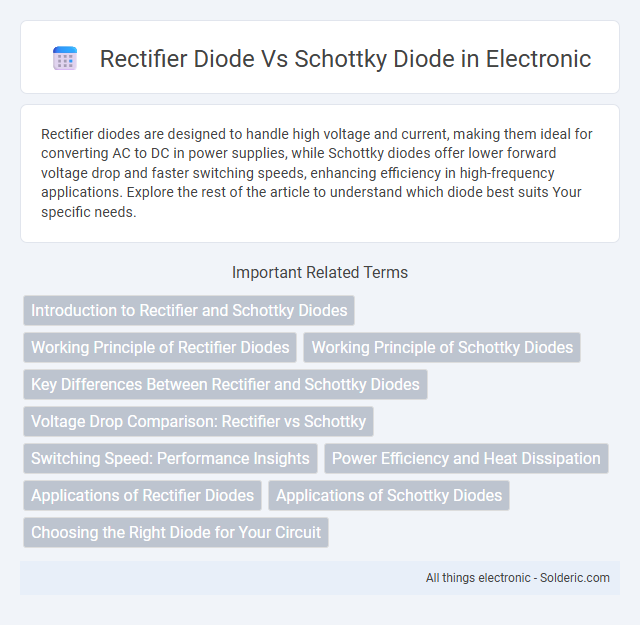Rectifier diodes are designed to handle high voltage and current, making them ideal for converting AC to DC in power supplies, while Schottky diodes offer lower forward voltage drop and faster switching speeds, enhancing efficiency in high-frequency applications. Explore the rest of the article to understand which diode best suits Your specific needs.
Comparison Table
| Feature | Rectifier Diode | Schottky Diode |
|---|---|---|
| Construction | P-N Junction Semiconductor | Metal-Semiconductor Junction |
| Forward Voltage Drop (Vf) | 0.7V (approx.) | 0.2V to 0.3V (low Vf) |
| Switching Speed | Moderate | Very Fast (High-Speed Switching) |
| Reverse Recovery Time | Longer (microseconds) | Shorter (nanoseconds) |
| Leakage Current | Low | Higher than rectifier diode |
| Applications | Power Rectification, Voltage Regulation | High-Speed Switching, Power Supply, RF Applications |
| Efficiency | Lower due to higher voltage drop | Higher efficiency due to low voltage drop |
| Cost | Generally lower | Generally higher |
Introduction to Rectifier and Schottky Diodes
Rectifier diodes are semiconductor devices designed primarily for converting alternating current (AC) to direct current (DC) through controlled conduction, commonly used in power supplies and electronic circuits. Schottky diodes, characterized by their low forward voltage drop and fast switching speed, are ideal for high-frequency applications and minimizing power loss. Understanding the differences in material composition and performance allows you to select the appropriate diode for efficiency and reliability in your electronic designs.
Working Principle of Rectifier Diodes
Rectifier diodes operate by allowing current to flow in one direction while blocking it in the opposite direction, utilizing a PN junction that becomes forward biased under positive voltage and reverse biased under negative voltage. This unidirectional behavior enables efficient conversion of alternating current (AC) to direct current (DC) in power supply applications. Understanding this working principle highlights why rectifier diodes are essential components in electrical circuits requiring controlled power flow.
Working Principle of Schottky Diodes
Schottky diodes operate based on the metal-semiconductor junction rather than the p-n junction found in rectifier diodes, resulting in a lower forward voltage drop typically ranging from 0.15 to 0.45 volts. This unique construction enables faster switching speeds and reduced power loss, making Schottky diodes ideal for high-frequency applications and power rectification in switching power supplies. The majority carrier conduction mechanism in Schottky diodes contributes to their efficient performance and minimal recovery time compared to conventional rectifier diodes.
Key Differences Between Rectifier and Schottky Diodes
Rectifier diodes are designed for high voltage and current handling with slower switching speeds, making them ideal for power conversion in AC to DC applications, while Schottky diodes prioritize fast switching and low forward voltage drop, enhancing efficiency in high-frequency circuits and power supplies. The key differences include the rectifier diode's higher reverse recovery time compared to the Schottky diode's minimal recovery time, which reduces switching losses and heat generation. Your choice depends on whether your application demands durability and high voltage tolerance or rapid switching and energy efficiency.
Voltage Drop Comparison: Rectifier vs Schottky
Rectifier diodes typically exhibit a forward voltage drop ranging from 0.7 to 1.1 volts due to their silicon-based PN junction, resulting in higher power dissipation in high-current applications. Schottky diodes, constructed with a metal-semiconductor junction, offer significantly lower forward voltage drops between 0.15 and 0.45 volts, enhancing efficiency and reducing heat generation. This voltage drop advantage makes Schottky diodes ideal for switching power supplies and high-frequency circuits where energy efficiency and fast recovery time are critical.
Switching Speed: Performance Insights
Rectifier diodes typically exhibit slower switching speeds due to their higher charge storage and recovery times, making them less suitable for high-frequency applications. Schottky diodes, constructed with a metal-semiconductor junction, offer significantly faster switching speeds and low forward voltage drop, which enhances efficiency in power supply circuits and RF systems. These performance insights make Schottky diodes preferable in switching applications requiring rapid response and reduced power loss.
Power Efficiency and Heat Dissipation
Rectifier diodes typically have higher forward voltage drops around 0.7V, resulting in greater power loss and heat generation compared to Schottky diodes, which feature lower forward voltage drops between 0.2V and 0.4V. This lower voltage drop in Schottky diodes enhances power efficiency, reducing energy wasted as heat and improving thermal management in electronic circuits. Consequently, Schottky diodes are preferred in applications requiring high efficiency and minimal heat dissipation, such as power supplies and high-frequency switching circuits.
Applications of Rectifier Diodes
Rectifier diodes are predominantly used in power supply circuits for converting alternating current (AC) to direct current (DC), essential in devices like battery chargers, power adapters, and voltage regulators. Their high reverse voltage rating and durability make them suitable for high-voltage and high-current applications in industrial equipment and automotive electronics. Compared to Schottky diodes, rectifier diodes handle larger power loads but switch slower, making them less ideal for high-frequency applications.
Applications of Schottky Diodes
Schottky diodes are widely used in high-frequency switching applications such as power rectification in SMPS (Switched-Mode Power Supplies) and RF (Radio Frequency) circuits due to their low forward voltage drop and fast switching speeds. They are essential in solar panel systems for preventing backflow current and enhancing efficiency by minimizing power loss. Schottky diodes also play a critical role in clamping circuits and voltage clamping protection because of their rapid response and low capacitance characteristics.
Choosing the Right Diode for Your Circuit
When choosing the right diode for your circuit, consider that rectifier diodes, such as the 1N4001, offer higher voltage and current handling, making them ideal for power conversion and protection applications. Schottky diodes provide lower forward voltage drop and faster switching speeds, which enhance efficiency in high-frequency or low-voltage circuits like power supplies and RF systems. Your selection should balance the trade-offs between efficiency, speed, and voltage requirements to optimize circuit performance.
Rectifier diode vs Schottky diode Infographic

 solderic.com
solderic.com